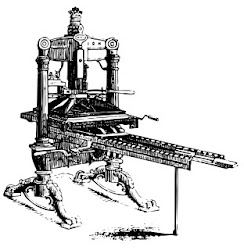Where it came from is unknown as I never worked in a print shop, took printing classes in school or ever wanted a press. I do have a vague memory of my 1950s high school printshop. I wandered in and out a few times but always was told it wasn't for me as I was smart enough to go to college. I never looked back and my schooling lead me on to a path in the sciences, evolutionary biology to be specific. My career mostly consisted of being an extended graduate school student, heavily into research, writing scientific papers and other such academic pursuits. I then met my wife who was an artist, about as far from the sciences as you can get. At the time she was pursuing her dream of becoming a jewelry designer. So with a bit of money and a lot of hard work we ended up opening a gallery where she could make jewelry and I could use my scientific background to solve whatever problems needed solving.
While on vacation in Michigan one hot summer, we haunted the antique stores. Deep in the recesses of one shop, I noticed a small press, totally rusty, but it was quite inexpensive, so home it went. I knew it had to be cleaned before being used for printing, so we looked up a sandblasting shop, brought it in, and an hour later I had a bare metal press. I was told to paint it as soon as possible otherwise it would quickly rust. A can of spray paint, some taping of parts which shouldn't be painted, and I had a press.
This first press was a Kelsey Excelsior 5x7. I read a few books, no internet at that time, and was ready to print. Bought a pair of rollers and gave it a try. I applied to the APA, was accepted, and printed a few pieces. I soon realized I needed some help so I decided to take a class in letterpress. I enrolled at Artists' Book Works, at the time about the only place in Chicago to offer such classes. I took one, then another and another. Classes were small, taught by great people. My classmate for many of these classes was Amos Kennedy, Jr, who was learning his future craft.
 I decided I wanted a larger press, so I attended an auction held at a closed printing plant, bid on and won a Vandercook #4 for $75. A few years later, needing space, I sold it for $300. Later, longing for another press, I bought a Model #3 for $65. Once again, a few years later I needed space, so out it went to reside at Paul Aiken's Museum, where it haunts me every time I see it. Along the way were the Kelseys, Sigwalts, and small Goldings. All are gone now.
I decided I wanted a larger press, so I attended an auction held at a closed printing plant, bid on and won a Vandercook #4 for $75. A few years later, needing space, I sold it for $300. Later, longing for another press, I bought a Model #3 for $65. Once again, a few years later I needed space, so out it went to reside at Paul Aiken's Museum, where it haunts me every time I see it. Along the way were the Kelseys, Sigwalts, and small Goldings. All are gone now.It wasn't a good pattern, buy a press, sell a press. Of course, like so many that enter the field later in life, I never entertained the idea of making money. I missed my presses and I just wanted a new one. Many were available but settling on one which would have to last the rest of my life was a difficult choice.
In my life as a bookseller, many books pass through my hands every day. One day, in a box of books that I'd purchased was a copy of Printing with the Handpress by Lewis M. Allen. That was it, I wanted a handpress. Knowing the cost of such presses, reality soon dashed my desire. Oh well, I thought, maybe I'll win the lottery...






